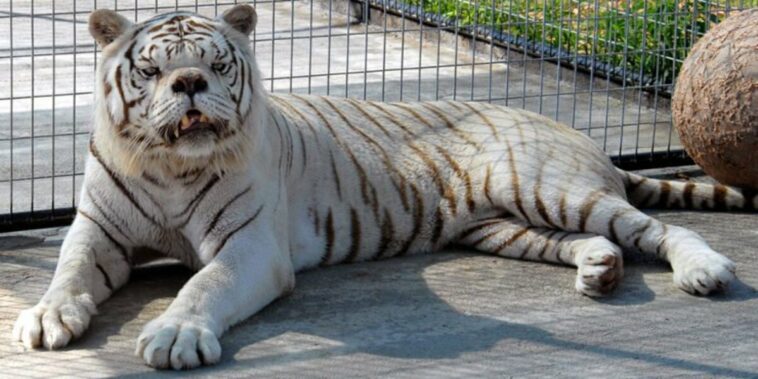Kenny, that was the name of a unique white tiger that was born in captivity at the animal “refuge” in Eureka Springs, Arkansas, United States, as a product of an experiment.
Kenny, the white tiger with Down’s Syndrome
Kenny, that was the name of a unique white tiger that was born in captivity in the animal “refuge” of Eureka Springs, Arkansas, United States, as a product of an experiment.
Many zoos that make money by imprisoning, exploiting and exhibiting innocent animals know they are making a good investment, which is why they appreciate white, blue-eyed tigers.
However, as the number of these wild animals has continued to decrease, this genetic variety is limited and many cubs are born with health problems.
It was then that the specialists at the Arkansas refuge thought they could modify the DNA to obtain blue-eyed white tigers effortlessly.
The result of that experiment was Kenny, who was born with Down Syndrome, problems in his jaw, teeth, deficits in his mental development and others. Although he lived in peace and good care, he died in 2008 of cancer.
Are there really animals with Down Syndrome?
The simple answer is NO, no animals with this genetic anomaly have been found in nature. But Kenny was not born naturally.
All living beings have different combinations of genes, which are grouped together to form chromosomes and make up our DNA.
Obviously, not all living beings have the same number of chromosomes. Moreover, each species has a characteristic number: 5 for flies, 38 for cats and tigers, 40 for pigs, 46 for humans, 78 for dogs… It is important to note that there is no direct relationship between the number of chromosomes and the size or evolutionary development of species.
To give an example, there are species very different from each other but with the same number of chromosomes: for example, the hare has 46, like man. In contrast, our evolutionary “cousins”, the chimpanzee, the orangutan and the gorilla have 48 pairs, the same as a potato.
In the laboratory
Knowing that Down Syndrome is a genetic alteration caused by a trisonomy in the 21st pair (i.e. where there should be 2 “packages of genes or chromosomes” we find 3), it can be said that if this trisonomy is provoked in other animals we could speak of the same alteration.
But depending on the species, genetic information is not always configured in the same pair of chromosomes, scientists can determine the patterns. For example, during studies with laboratory mice it has been found that in their chromosome 16 there is a good number of genes similar to that of the human chromosome 21 and, moreover, ordered in a similar way.
Therefore, scientists have forced this trisonomy in mice, in order to understand our human Down syndrome in the laboratory.
And although it is not the same case, experts claim that Kenny also had a trisomy in one of his genes. Unfortunately, Kenny was in the media long after his death and by then his remains had already been cremated before more conclusive tests could be carried out.
- Facebook Messenger

